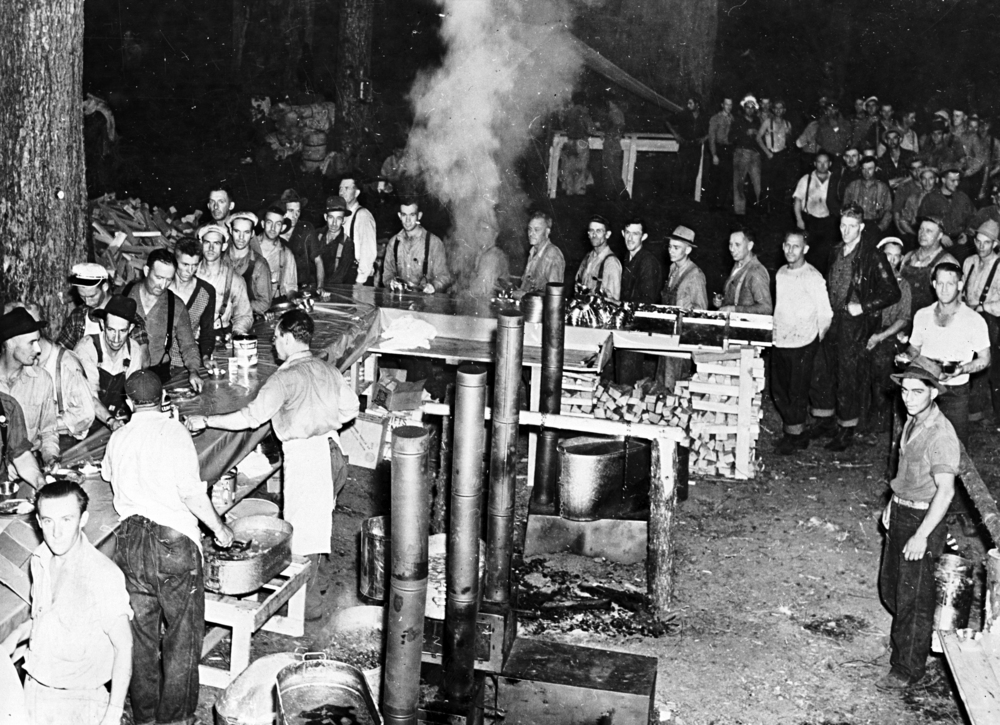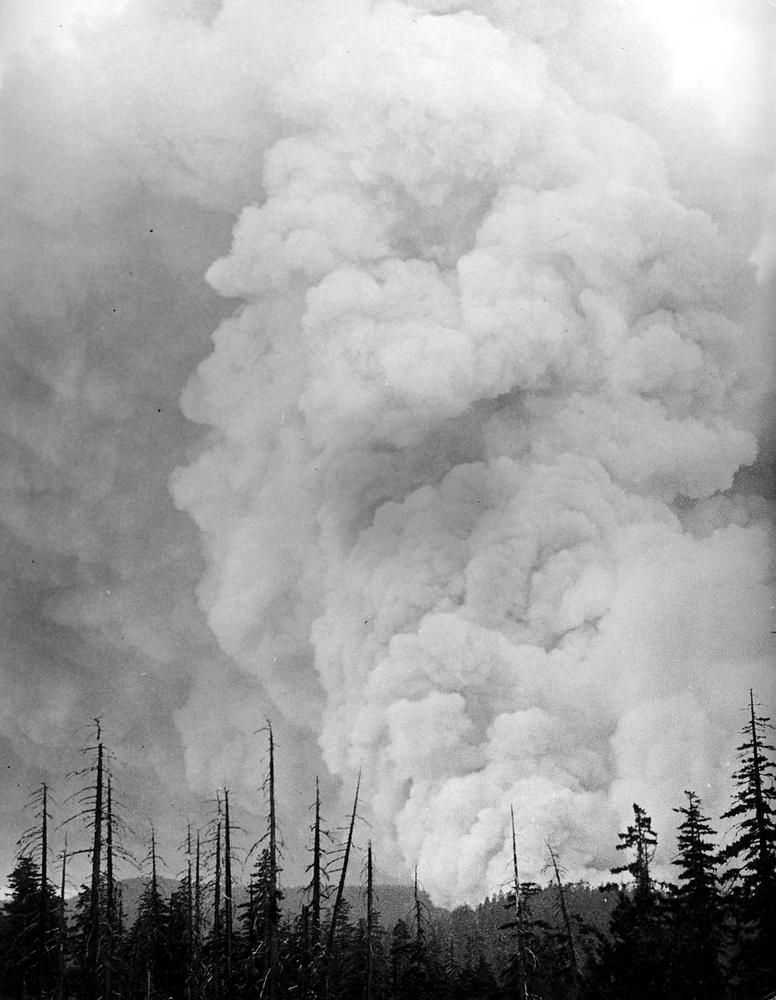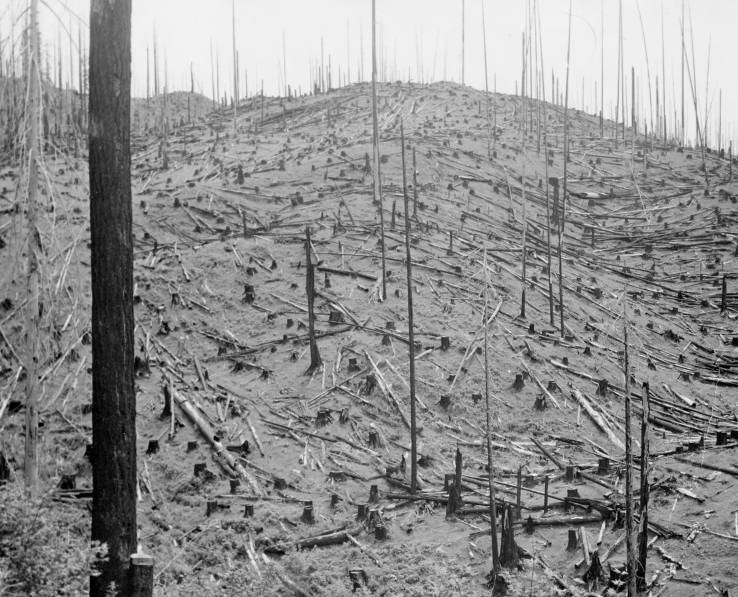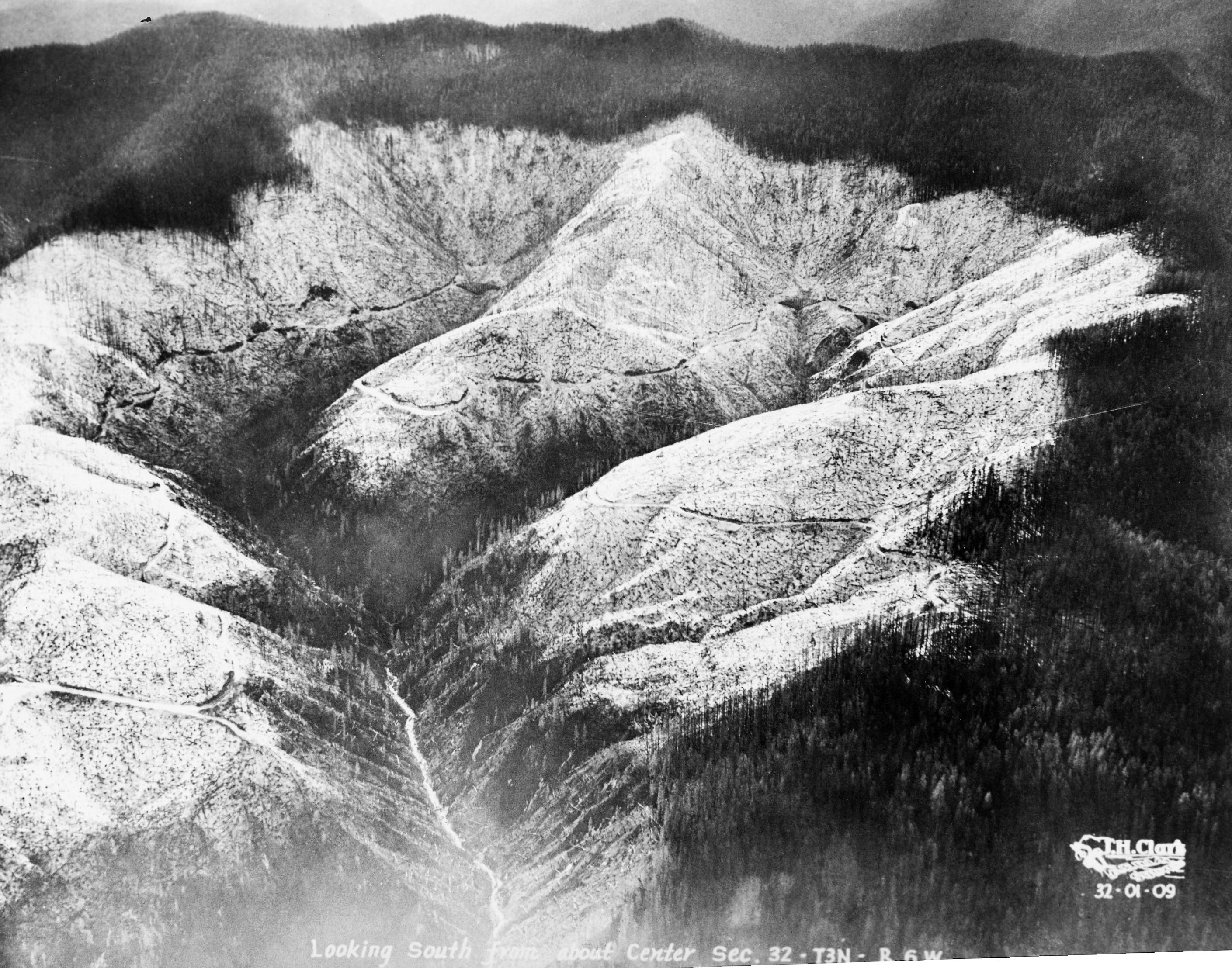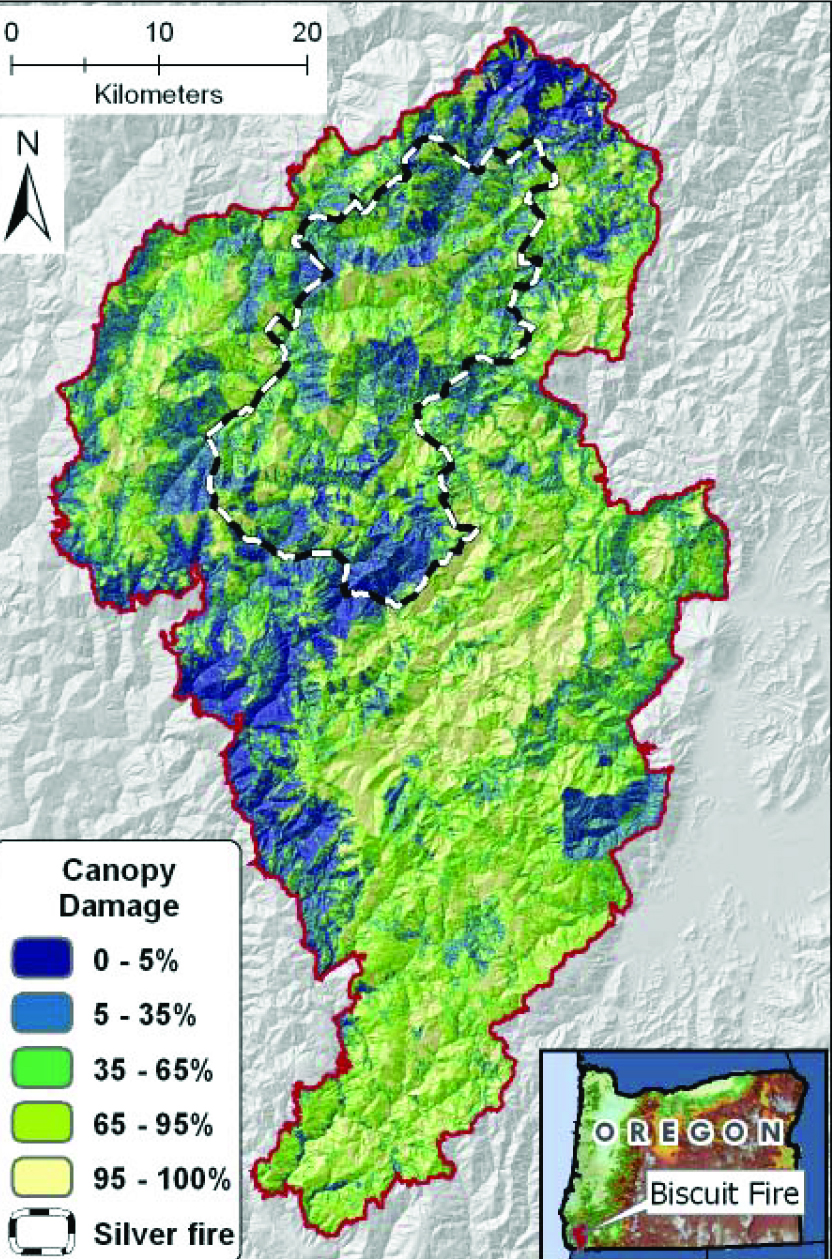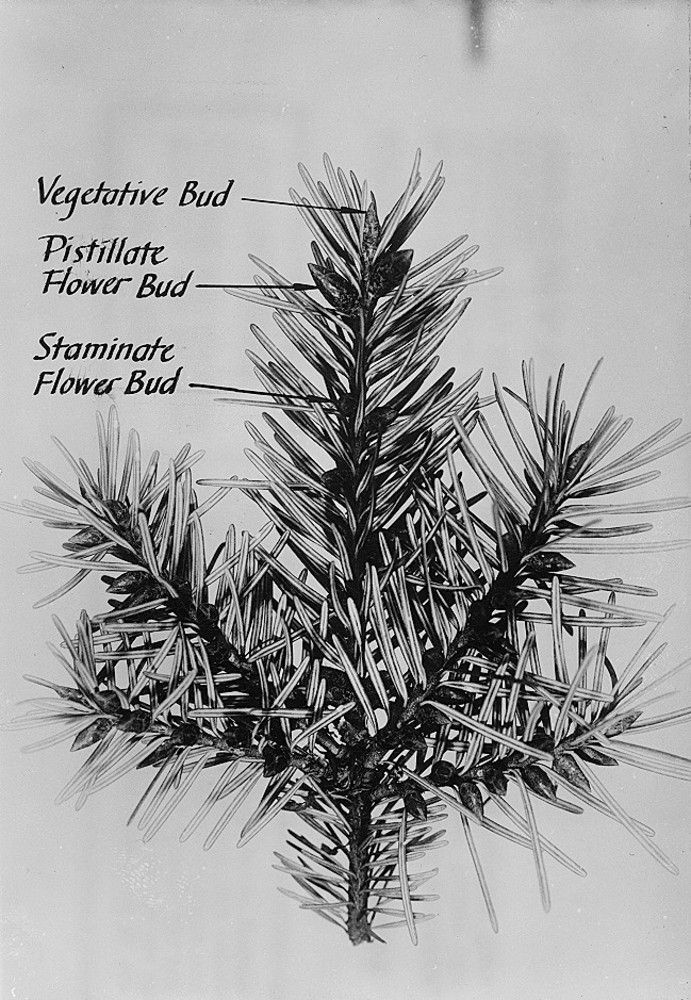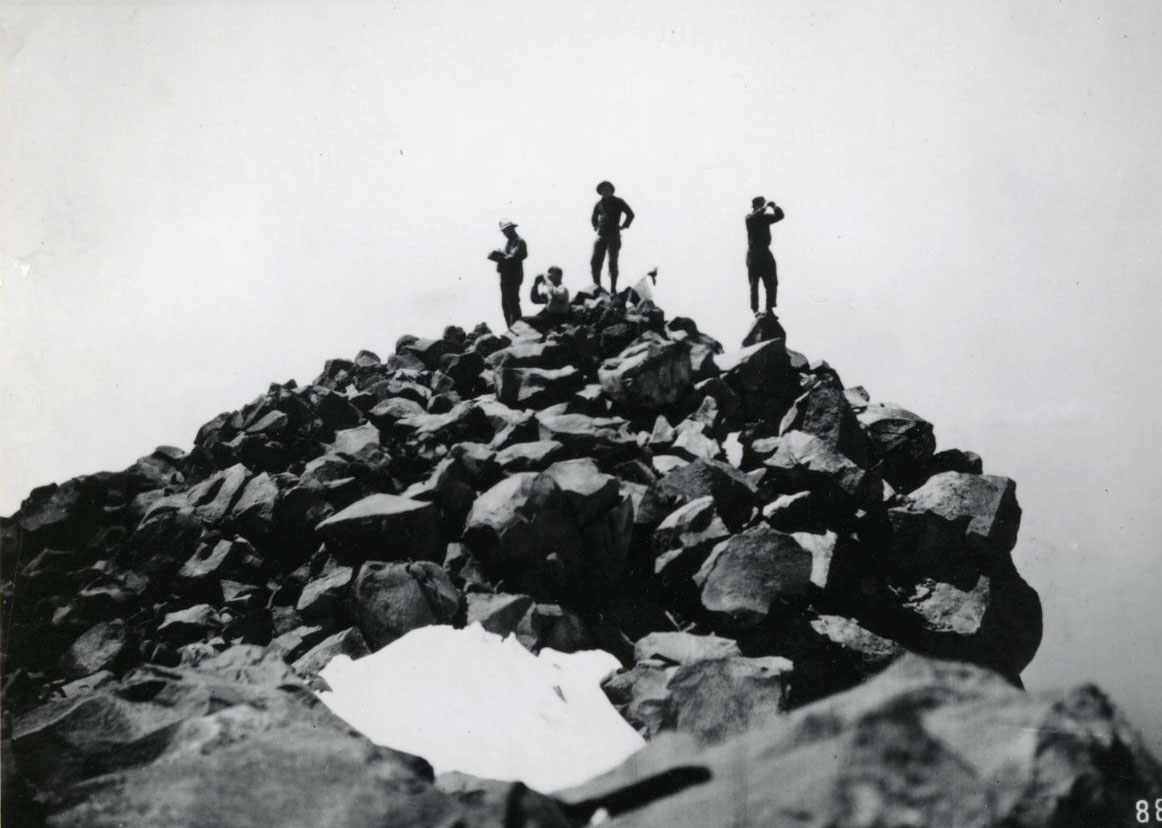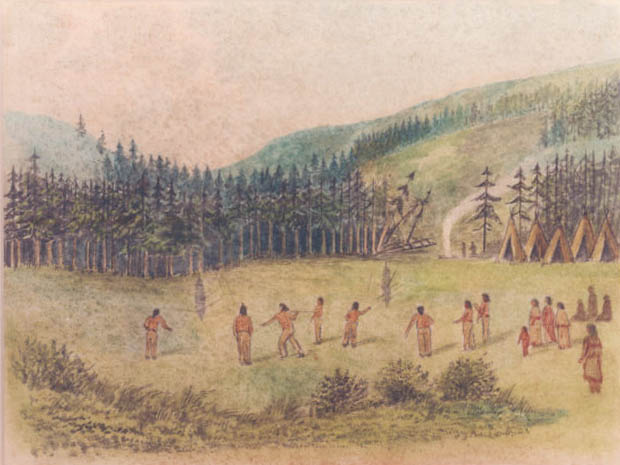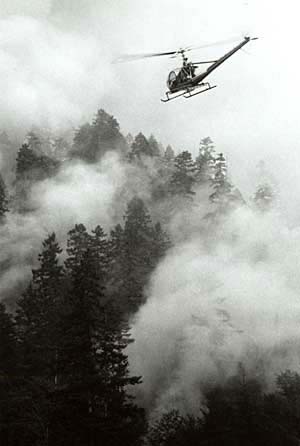The Tillamook Burn was a catastrophic series of large forest fires in the northern Oregon Coast Range mountains 50 miles west of Portland. It began in 1933 and struck at six-year intervals through 1951, burning a combined total of 355,000 acres (554 square miles). For a generation of Oregonians whose lives were touched by the fires, "The Burn" also became a place, defined by the overall perimeter of the combined fires (as in, "Let's drive up into The Burn to see if we can find some deer...").
The largest of the four fires—and the most devastating—began about noon on August 14, 1933, in a logging operation on the slopes above the North Fork of Gales Creek, west of the town of Forest Grove. The near-record weather conditions on that day (104 degree temperature with a relative humidity of about 20 percent), a tinder dry forest ready to burn, and the remote location of the fire, combined to ignite and feed a challenging fire.
Loggers working in the area at the time offered intriguing explanations for how the fire started, but official investigation reports that have stood the test of time identified it as stemming from friction generated when a large Douglas-fir log was dragged across a downed tree. The fire started in a large area of extremely flammable logging debris at the end of a railroad spur. Within an hour, the fire burned through sixty acres of logging slash. The loggers made a valiant effort to fight the fire, but their tools consisted primarily of shovels and hoes and depended entirely on the strength and fire experience of men who could be drafted to help. By nightfall, it was clear the fire had the upper hand and would spread into valuable timber to the south and west.
The steep country of the surrounding Coast Range was mostly inaccessible: today's Wilson River Highway (Oregon 6) and the Sunset Highway (US 26) did not yet exist. When the fire started, the entire area—including the wider landscape of the Coast Range—was privately owned. Logging operations had begun to work around the edges of what remained as one the largest uncut and roadless areas of the Coast Range.
In ten days, the fire had burned 40,000 acres (more than 60 square miles), but that was dwarfed by what happened the evening of August 24th. Pushed by strong east winds, the fire exploded to 240,000 acres in twenty hours, exhibiting some of the most rapid forest fire growth recorded in the 20th century. The several thousand firefighters (including volunteers, loggers, farmers, and several hundred men from the Civilian Conservation Corps) had all they could do to stay out of the way as the firestorm mushroomed over the Coast Range.
The 1933 fire crept across the Coast Range until early September, when its forward spread was stopped by rain, though it continued to smolder for months. Salvage logging started up not long after—the dead trees were felled and shipped to surrounding mills— and ebbed and flowed over the years with the changing lumber market.
The 1933 fire primed the landscape for additional fires. Year after year, the standing dead trees dried out, becoming a powder keg awaiting ignition. That came in 1939, when 209,000 acres were burned, including 19,000 acres of previously unburned forest; in 1945, when two fires burned 182,000 acres, almost all of which had previously burned; and in 1951, when two fires burned a total of 32,700 acres of forest. All three of the subsequent fires began in logging operations.
By 1951, the lands had begun to transition into public ownership. Rather than pay property tax on the burned-over lands, many private land owners, already reeling from The Depression and the devastating losses of the fires, let their taxes go delinquent and forfeited the land to the county. In the 1940s and 1950s, county governments (primarily Yamhill, Washington, and Tillamook) agreed to transfer the lands into state ownership, and in return the counties received a portion of future revenues from timber harvests. This important statutory arrangement continues to define management of the lands today.
In addition to the nearly complete change of land ownership patterns, epic-sized fire protection and reforestation programs were also launched by the Oregon Department of Forestry to prevent future fires and to restore the haunting, blackened landscape to green forest.
Between 1949 and 1972, more than 72 million seedlings were planted by hand across the former burned area, and a billion Douglas-fir seeds were dropped from helicopters. Young people from throughout northwest Oregon came to The Burn in buses and helped plant almost a million seedlings.
The collective impact of the fires, the salvage operations, and the reforestation defined the consciousness of at least two generations of Oregonians, spawning everything from collectible memento coins, to campfire songs, frequent front page news coverage, and children's books about the fires and the forest.
Oregon Governor Tom McCall, marking an end to reforestation of the burned-over area, helped to write the closing chapter of the Tillamook Burn story when he visited in June 1973. He told a gathered crowd of tree planters, foresters and dignitaries, that from that point forward, the "Tillamook Burn" was to be known as the Tillamook State Forest.
Visitors to the forest today have to look hard to find clues to its fiery past. But the legacy of the Tillamook Burn will shape the landscape for generations to come.
-
![]()
Tillamook Burn historical marker, on Highway 6.
Oreg. Hist. Soc. Research Lib., bb004579
-
![]()
Tillamook Burn, 1933.
Oreg. Hist. Soc. Research Lib., bb004576
-
![]()
Meal line at camp for Tillamook Burn fire fighters..
Oreg. Hist. Soc. Research Lib., bb004582
-
-
![]()
Tillamook Burn, ravine and burned timber.
Courtesy Tillamook County Pioneer Museum, 77.176.AE -
![]()
View of north side of Northrup Creek (Clatsop County) after burn, June 1941.
Courtesy OSU Special Collections & Archives Research Center, Oregon State University. "View of north side of Northrup Creek" Oregon Digital -
![]()
Tillamook Burn, 1933.
Courtesy Tillamook County Pioneer Museum
Related Entries
-
![Biscuit Fire of 2002]()
Biscuit Fire of 2002
On July 13, 2002, a series of electrical storms passed over southwester…
-
![Douglas-fir]()
Douglas-fir
Douglas-fir (Pseudotsuga menziesii), perhaps the most common tree in Or…
-
![Forest Fires of 1910]()
Forest Fires of 1910
During the late summer of 1910, a searing drought combined with high-ve…
-
![Indian Use of Fire in Early Oregon]()
Indian Use of Fire in Early Oregon
Anthropogenic (human-caused) fire was a major component of the Native s…
-
![Oxbow Ridge Fire of 1966]()
Oxbow Ridge Fire of 1966
Oregon’s forests were extremely dry in August 1966. Hot east winds bega…
Related Historical Records
Map This on the Oregon History WayFinder
The Oregon History Wayfinder is an interactive map that identifies significant places, people, and events in Oregon history.
Further Reading
Ellis Lucia, The Big Woods. New York: Doubleday & Company, 1975.
Ellis Lucia, Tillamook Burn Country. Originally published 1983 by Caxton Printers, Caldwell, Idaho. Updated and republished 2007 by the Tillamook Forest Heritage Trust, Forest Grove, Oregon.
Gail Wells, The Tillamook: A Created Forest Comes of Age. Corvallis: Oregon State University Press, 2nd edition, 2004.
Larry J. Kemp, Epitaph for the Giants. Portland: Touchstone Press, 1967.
Linda Crew, Fire on the Wind. Delacorte Books for Young Readers, 1995.
Stewart Holbrook, Burning an Empire. New York: McMillan Company, 1943.



